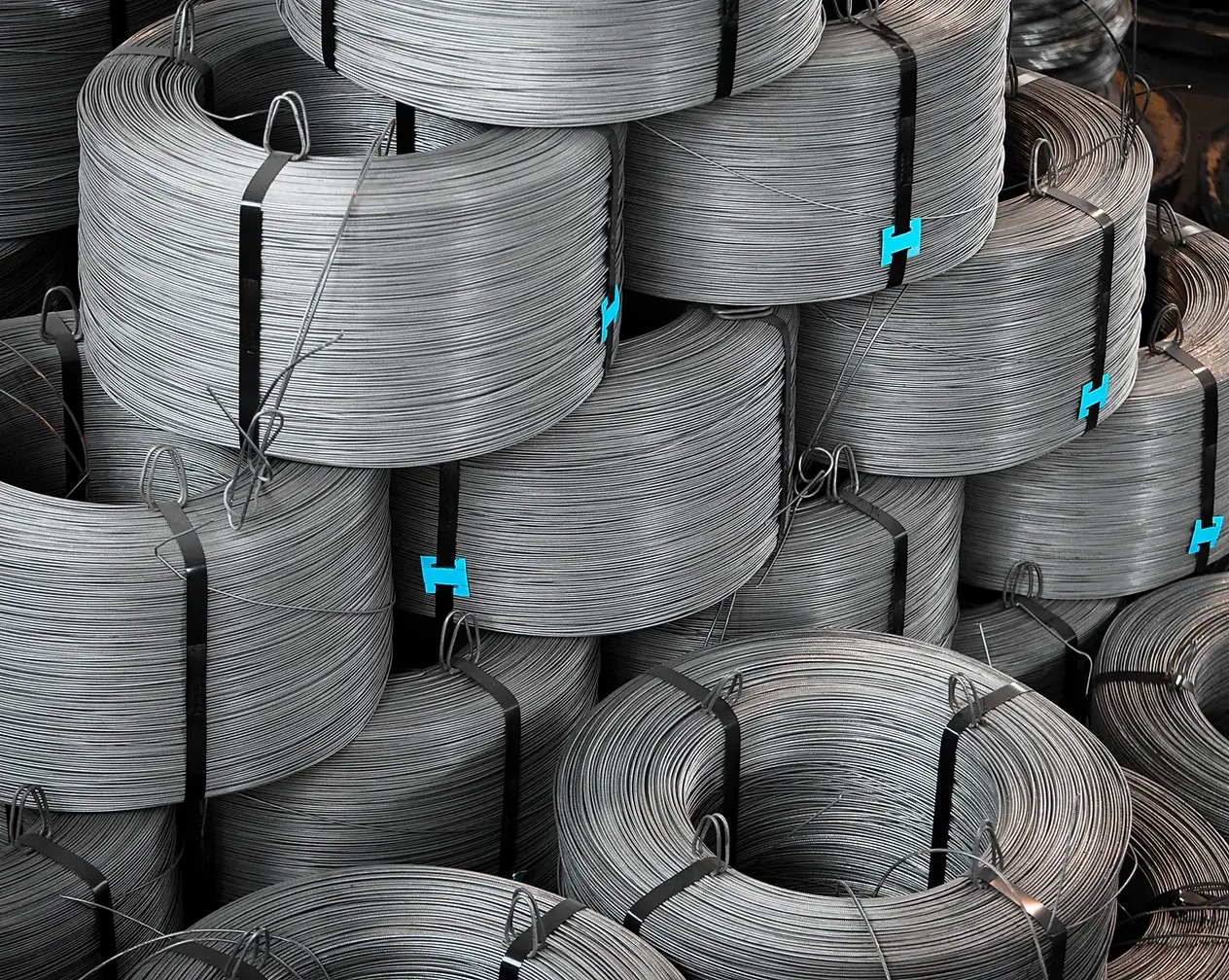Safety lock wire, also known as wire locking or safety wire, is a type of positive locking device that prevents fasteners from loosening or falling out due to vibration and other stresses.
The primary purpose of safety lock wire is to secure fasteners and other components, providing an added layer of safety and security in various industries, most notably in aerospace and defense.
The concept of safety lockwire dates back as early as the advent of aviation. Early aircraft were subjected to intense vibrations, which often caused fasteners to loosen, resulting in mechanical failures. To combat this, a safety lock wire was introduced.
Over the years, the use of safety wiring has extended beyond aerospace, finding its place in any application where safety and security are of utmost importance. Today, it continues to play an essential role in maintaining operational safety and efficiency, testifying to its enduring relevance in the mechanical world.
Whether you need aluminum wire, stainless steel wire, copper wire, or brass safety wire, knowing more about this topic is essential for you to make the right assessment and get the best products. Read on to find out everything.
Types of Safety Lockwire
A. Stainless Steel Lockwire
Stainless steel lock wire is a popular choice when it comes to installing safety wire due to its high resistance to heat and corrosion. Made from 304 stainless steel, it’s famous for its tensile strength and its ability to perform under extreme conditions, making it perfect for use in industries such as aerospace and defense.
This safety wire is easy to work with, resists fraying, and holds its shape well. There will be variants on the results you get depending on whether you rely on a single-wire method, a double-wire method, and other electrical systems for you to get the results you want. However, it’s still one of the most popular alternatives.
B. Inconel Lockwire
Inconel Lockwire is known for its high temperature and corrosion resistance, making it an ideal choice for industries that work in more demanding environments.
It’s made from a family of superalloys composed of nickel and chromium and can retain its strength even when exposed to temperatures up to 2000°F. This type of lockwire is particularly beneficial in applications, such as fastening critical components in aircraft engines, where high heat is common.
C. Monel Lockwire
Monel Lockwire is made from a series of nickel-copper alloys. Known for its excellent strength and corrosion resistance, particularly against seawater and acids, this type of lock wire is often used in marine and chemical applications.
Despite its strength, Monel Lockwire is also highly malleable, making it easier to secure fasteners in tight or awkward spaces.
The Mechanics Behind Safety Lockwire
A. Wire Gauge and Thickness
The wire gauge and thickness of the safety wire are critical aspects of its performance and strength. With a diameter of 0.047 inches, this specific lockwire is designed to provide the right balance between flexibility and sturdiness.
The thickness allows the wire to be effectively threaded through fasteners, without compromising its resistance to stress or strain.
Thicker wires tend to have greater strength, but they may lack the flexibility needed for secure installation. Hence, selecting the right gauge and thickness is a defining factor for the effectiveness of the safety wire.
B. Tension and Torque Considerations
Safety lockwire works primarily through the application of tension and torque. Once threaded and twisted around the fasteners, the tension in the wire prevents the loosening of these components.
The wire is designed to maintain this tension, even under conditions of high vibration or sudden impact. Furthermore, the torque applied during the installation process ensures that the wire is tightly wound and secures the fasteners effectively.
However, it is crucial to consider the torque limit of the wire to avoid over-tightening, which could lead to the wire’s failure. Therefore, understanding and applying the correct tension and torque is key to maximizing the effectiveness of the safety lock wire.
Industries Utilizing Safety Lockwire
A. Aviation
The aviation industry heavily relies on safety lock wire. It is primarily used to secure fasteners on aircraft, ensuring that vibrations or other factors do not loosen during flight.
The usage of safety lockwire in this industry is not only a standard practice but a regulatory requirement to maintain aircraft safety and integrity.
B. Automotive
In the automotive industry, safety lock wire is extensively used to secure elements of high-performance vehicles, racing cars, and motorcycles.
These vehicles often undergo severe vibrations and stresses, leading to the loosening of fasteners. Safety lockwire helps prevent any such incidents and ensures the proper functioning of vehicles, especially in high-stakes racing environments.
C. Oil and Gas
Safety lockwire also finds significant application in the oil and gas industry. It is used in securing fasteners and fittings in oil rigs, pipelines, and processing facilities.
The conditions in these facilities can be extremely harsh, with high pressures, vibrations, and corrosive elements. Safety lockwire ensures that the fasteners do not loosen or fall off, preventing possible leaks or accidents, and maintaining the integrity and safety of the entire operation.
Installation Techniques
Proper installation of the safety wire is as important as the lock wire itself. There are several techniques to secure fasteners effectively, where the most common are the Double Twist Method and the Single Twist Method.
A. Double Twist Method
The Double Twist Method is commonly used when securing two or more fasteners together. After threading the wire through the fasteners, equal lengths of the wire are twisted together between the fasteners.
The twisting creates a tight bond, preventing the fasteners from loosening under stress or vibration. This method is typically used in scenarios where multiple fasteners are in close proximity.
B. Single Twist Method
The Single Twist Method, on the other hand, is typically used when the lockwire is securing a single fastener. In this method, the wire is threaded through the hole of the fastener and then twisted around itself, forming a loop.
The remaining end of the wire is then twisted back onto itself to lock the loop in place. This is a simpler process but is also effective in preventing the disengagement of the fastener.
C. Application Specifics
While the above methods are standard, it is vital to adjust your technique depending on specific applications. For example, the direction of the twist and the tightness of the wire may depend on the direction of rotation of the fastener, its size, and its material.
Always ensure to consult the guidelines provided by the manufacturer or industry standards for specific applications.
Compliance and Standards
At American Wireworks, we take the issue of compliance and standards very seriously. This ensures that the products we supply are safe, reliable, and of the highest quality.
A. Regulatory Bodies
Our safety wires are produced in full compliance with the directives of the National Aerospace Standards (NASM) and the Defense Federal Acquisition Regulation Supplement (DFARS). These bodies set stringent safety, quality, and technical standards for products used in the aerospace and defense industries.
B. Certification Requirements
To underscore our commitment to quality and safety meet all necessary certification requirements. This includes the MS20995C47 specifications and the NASM 20995 standards. These certifications affirm our lockwire’s suitability for use in securing fasteners in high-stress environments.
C. Quality Control Measures for Our Safety Wire Options
Our in-house quality control measures are comprehensive and thorough. We conduct rigorous checks at every stage of the manufacturing process, from sourcing of raw materials to packaging of the final product. This ensures that only defect-free, high-performance lockwire reaches our clients. Our commitment to quality control has made us a trusted supplier in the aerospace and defense industries.
Advantages of Safety Lock Wire
Safety lock wire offers several significant benefits, making it an indispensable tool in various industries, especially aerospace and defense. Here are some key advantages:
A. Enhanced Safety
The primary advantage of safety lock wire is the enhanced safety it provides. It keeps critical fasteners, such as nuts, bolts, and turnbuckles, securely in place, reducing the risk of these pieces loosening and causing mechanical failures.
This heightened level of safety is crucial, especially in industries where even the slightest mechanical failure can have catastrophic consequences.
B. Preventing Vibrational Loosening
Safety lockwire is specifically designed to combat the detrimental effects of vibration, a common issue in aerospace and defense environments.
By keeping the fasteners intact under conditions of high vibration, the safety wire effectively prevents vibrational loosening, ensuring the continued secure operation of the components.
C. Corrosion Resistance
Safety lockwires, particularly those made of stainless steel, boast superior corrosion resistance. This quality makes them highly durable even in challenging environments, significantly extending the lifespan of the components they secure. The corrosion-resistant nature of safety lock wire minimizes the need for frequent replacements, offering long-term reliability and cost-efficiency.
Summary of Best Practices
To reiterate, traditional safety wire plays a vital role in industries like aerospace and defense. This high-quality locking wire helps secure fasteners and prevent their dislocation, a critical safety measure given the stressors common in such work environments.
Overall, safety wire helps you ensure that there will be no safety hazard that can harm you. Just as first aid kits and portable fire extinguishers are needed in certain industries, safety wire is part of making sure you’re always safe. It helps you reinforce your emergency equipment.
Furthermore, American Wireworks is renowned for its commitment to quality, reliability, and customer focus, offering both in-stock and custom wire options to cater to a variety of needs.
The importance of safety in high-stress fields like aerospace and defense cannot be overstated. Using superior-quality lockwire significantly reduces the risk of mechanical failure and, therefore, improves safety standards. It is vital to choose a reputable and trusted supplier, such as American Wireworks, when procuring these mission-critical components.
Doing so ensures not only the quality of the product but also the peace of mind and confidence to perform tasks without worrying about equipment failure.





